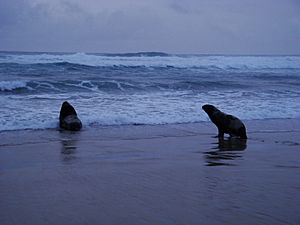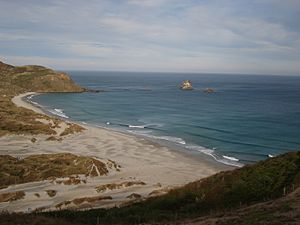Sandfly Bay facts for kids
Sandfly Bay is a beautiful sandy bay with huge sand dunes. It is located about 15 kilometers (9 miles) east of central Dunedin, New Zealand. You can find it on the southern side of the Otago Peninsula, between Seal Point and the Gull Rocks. Sandfly Bay is a special place for wildlife, managed by the Department of Conservation. Many people enjoy hiking and exploring this unique area.
Contents
What's in a Name?
You might think Sandfly Bay is named after the small biting insects called sandflies. Many local people believe this! However, that idea is actually incorrect. The bay got its name because of the sand itself. This part of the coast is often very windy. The strong winds make the sand "fly" from the tall dunes that surround the bay. So, it's the flying sand, not the insects, that gave the bay its name!
Exploring the Bay's Landscape
Sandfly Bay stretches about 1.5 kilometers (1 mile) across from one end to the other. On the western side, you'll see tall cliffs called Seal Point. These cliffs rise straight up from the sea for about 900 meters (2,950 feet). Just beyond Seal Point is another beach known as Boulder Beach.
On the eastern side of Sandfly Bay, there's a long, white sand beach about 1.1 kilometers (0.7 miles) long. A small stream called Morris Creek flows into the sea here. Towards the eastern end of the bay, the sand dunes are very tall, rising over 100 meters (330 feet) above the shoreline. These dunes form the lower part of a hill called Sandymount.
The beach ends at a rocky headland. Off this point, you'll see several small islands called the Gull Rocks. The biggest of these is known as Lion Rock or Lion's Head Rock. It looks like a lion's head, which makes it a famous landmark! On a clear day, you can even see it from Second Beach, near Saint Clair, about 18 kilometers (11 miles) to the west. East of this headland, the coastline of the Otago Peninsula turns towards the northeast at Harakeke Point.
You can reach Sandfly Bay by driving along Seal Point Road or by walking a track from Sandymount.
Amazing Wildlife

Sandfly Bay is a fantastic place to see wildlife, especially the rare yellow-eyed penguins. You can often spot them coming out of the sea in the evenings. If you see penguins, it's important to duck down and stay out of sight. This helps them feel safe and encourages them to go to their nests. At the eastern end of the beach, the Department of Conservation (DOC) has built special wooden hides. These hides allow people and DOC staff to watch the penguins without disturbing them.
The beach is also a favorite spot for New Zealand sea lions to rest on the sand. It's very important to stay at least 10 to 15 meters (33 to 49 feet) away from these animals. You should also avoid surrounding them. Sea lions can move surprisingly fast and have a very strong bite, much stronger than a dog's. Even though there are signs and rules, some visitors still get too close to the sea lions. Remember, keeping a safe distance protects both you and the animals!
You might also see many seabirds like spotted shags, sooty shearwaters, and variable oystercatchers. Sandfly Bay is also a great place to find large pieces of Durvillaea antarctica (kelp) that have washed ashore.
Fun Activities and Safety Tips
Sandfly Bay is most famous as a place for tramping (hiking). The main walking track starts from the carpark on Seal Point Road. It goes across farmland and then down a sandy slope to the beach, near where Morris Creek meets the sea. There are also viewing platforms along the way. Please note that mountain biking is not allowed on this track. Also, dogs are not permitted at Sandfly Bay because it is a wildlife reserve.
Another way to get to the bay is from Sandymount. This track takes you to the top of the dunes and then down the sandy face. Both routes can be quite challenging when you walk back up, as the sand dunes are soft and make it harder to climb.
Visitors also enjoy various sports on the beach. A popular activity is to slide down the huge sand dunes on old skateboards or other flat objects. It's a lot of fun!



